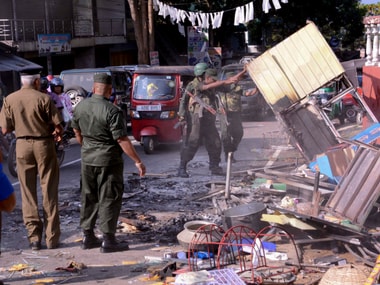One would think that Sri Lanka would hesitate to get into another bloody cycle of ethnic strife. After all, it’s just about seven years since the country actually declared itself at peace, and ended its last state of emergency. This time around, it seems that trouble has again flared — and flared badly — between sections of the island’s Sinhala majority and the Muslims, who are in a minority. According to the last census, Muslims make up 9.2 percent of the total population, and are concentrated in about four districts, accounting for between forty to thirty percent of the population in those districts. Nowhere are they a majority, unlike the Tamils who dominate in the north and have a significant presence in the east. The Tamils however, numbered only a little over 11 percent, and waged a war for over three decades. That’s an unsettling thought.
Trouble between the two seems to have risen following the end of the civil war, though tensions flared up from time to time even prior to that. The present violence seems to have started after a Sinhalese truck driver was beaten to death by a group of Muslims, probably in an incident of road rage at a suburb of Kandy. The matter was reportedly settled amicably with the intervention of local leaders from both communities. However, a mob from the majority community thereafter indulged in an orgy of violence, burning houses and shops of Muslims in Digana town on a scale not seen since 2014. The presence of two hardline Buddhist leaders allegedly fanned the fires of hatred, so easily inflamed in a country that has seen a generation born in violence.
If one analyses the facts, there would be little difficulty in concluding that the violence was inflamed deliberately. The government, to its credit, responded promptly to quell the violence, after the police were unable or according to some unwilling, to deal with the situation. The imposition of an emergency may seem extreme, but the move indicates the seriousness of the situation in a country that had seen continuous emergency for 40 years. Prime Minister Wickremesinghe has hinted that the violence was organised and systemic, comments that seem to have been fleshed out by the denials of former president Mahinda Rajapaksa — who was known to be soft on Buddhist hardliners during his tenure. The Sri Lanka Podujana Peramunna party ( SLPP) backed by the former president, recently won a thumping victory in local polls, winning 231 of 340 local councils. This is bad news for the shaky coalition headed by President Mathripala Sirisena. His faction of the Sri Lanka Freedom Party secured even fewer councils than the prime minister’s United National Party which won a mere thirty-seven. Notably, Rajapaksa attributed his win to his opposition to the sale of “national assets” to the Chinese, and among other things the rising cost of living. Incidentally, his party won more than 39 percent of the vote in the Kandy municipal elections. Following the present violence, his popularity will only rise further.
Media and analytical reports last year indicate rising Sinhala -Muslim clashes, with leaders of Sinhala mobs operating with impunity. Persons like Galagoda Aththe Gnanasara, general secretary of the Bodu Bala Sena — which in Sinhalese translates as Buddhist Power Force – even allege that the Muslims, despite being in the minority — have powerful friends from outside the country, a thinly veiled reference to international terrorist groups. It is a different issue that he himself has been at the centre of trouble recently, and that his many opponents accuse him of stoking anarchy. In addition, he has outside contacts too. Reports indicate that the BBS has links with hardline Buddhist leader Ashin Wirathu, who was a special guest at a rally of the BBS in September 2014. The Memorandum of Understanding signed between the two organisations warned of ‘subtle’ and foreign funded incursions adversely impacting Buddhism, and jointly promised to guard against ‘extreme conversions’ and other threats to the community.
If these are the ‘fundamentalists’ on one side — and the BBS is certainly one — reports over the last few years do indicate a rise in extremism among Muslims in Sri Lanka. Mohamed Muhsin Sharfaz Nilam a resident of Kandy, was one of the first to die under the banner of the Islamic State. Educated in Islamic doctrines in Pakistan, he left with his entire family including six children and his parents for Syria. It later emerged that he was leading a fight with 16 Sri Lankans. His posts were incendiary and extreme, and called for a war with all other religions. That was in 2015. The next year, the government claimed that 32 Sri Lankans from well established families had joined the Islamic State. In 2017, a video featuring a possibly Indian doctor, seemed to indicate that several Sri Lankan doctors were working for the Islamic State. With the Islamic State now in retreat, remaining recruits are likely to return.
It is more than well-known that there is serious trouble when politics meets competitive religious divides. The effect of such divisive and violent fissures on an already fragile state, only just recovering from a debilitating civil war is less clear. Even less clear are the contours of rising “militant Buddhism” which seems an anachronism in terms for what is one of the most admired and peaceful religions of all time.
What is fairly certain, however, is that Sri Lanka’s troubles will likely become India’s business if matters get worse. Already, the shrillness of the right in India in spurring the Buddhists on is apparent on social media. Better to offer counsel and help to douse this particular fire, sooner rather than later. Left to itself, it can only add debris and blood in a suddenly violent South Asia.
Published Date: Mar 08, 2018 20:07 PM | Updated Date: Mar 08, 2018 20:07 PM













